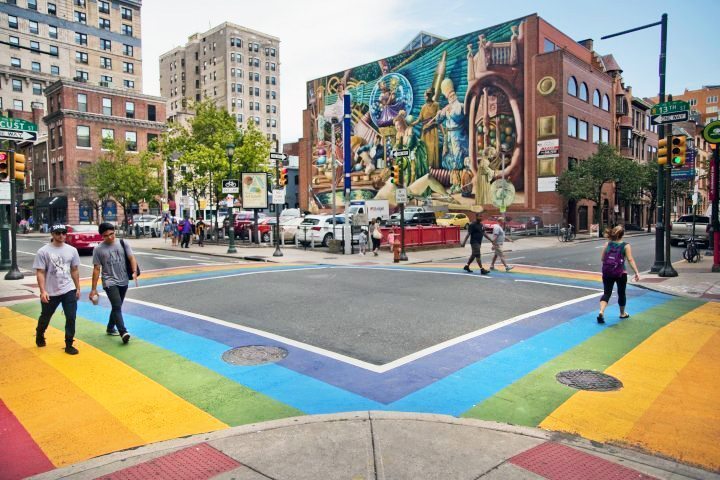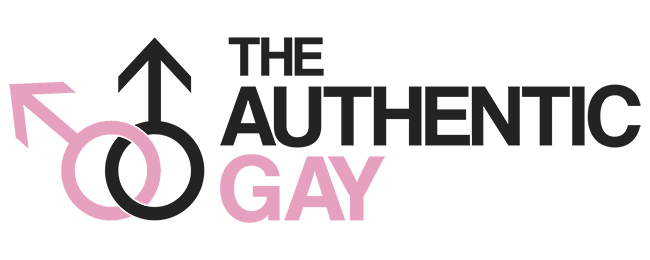The Gayborhood: Does Our Homogeneity Make Us Happy?

When I walk outside my apartment building I see gay. Approximately 25 gay bars are condensed into a 2-mile radius near my residence, countless gay-owned and gay-oriented clothing stores showcase the latest swimsuit line by ES Collection or 2Xist, gay couples hold hands while walking their dogs, and AHF billboard signs advocate for condom use and inform on the dangers of unprotected sex. My neighborhood hosts the annual gay pride events, is home to gay specialty interest groups such as dodgeball and volleyball leagues, and boasts a gay population percentage that is approximately 40x higher than that of the national average. In my neighborhood gay is the norm.
I could live in any nondescript gayborhood in America that shares the above features-the Castro in San Francisco, West Hollywood (Weho) in Los Angeles, Boystown in Chicago, Midtown Atlanta. Although these neighborhoods differ in factors unique to the host city such as the general demographic, socioeconomic characteristics, predominant industry, and weather, these “gayborhoods” share one common trait- they redefine “normal” with regard to sexual expression and gender identity.
Safe Haven or Policed Expression?
Many agree that these communities create a safe haven for queer people who otherwise might feel rejected by mainstream, heteronormative, western culture. However, as a result of queer culture defining the norm in a contained geographic location, businesses move in that aim to appeal to the majority of this population. Whether this takes the form of bars, nightclubs, retail stores, or hair salons, the successful ones are able to identify the most salient physical features and behavioral tendencies of our community (adjusting for factors like weather) and create products and services that cater to these attributes.
Take the nightlife scene as an example. Have you ever noticed that certain clubs only exhibit a specific “look” when it comes to contracting gogo dancers? Or in retail, how about the common experience of walking into any gayborhood’s clothing store and being unable to find a pair of jeans you like with a waist size between 28-30?
Whether good or bad, the effects of the gayborhood subculture’s socialization, occurring partially from increased commercialization and the production of targeted services/products, inherently alter the way we see the world. We are influenced by our peers, teaching us to categorize certain clothing lines as trendy while weeding out the unstylish. We learn to rate the attractiveness of certain physical traits from our repeated exposure to stimuli, such as the men on the advertisement labels of certain pre-workout products or invitations to Jeffrey Sanker events. No matter the method of internalization, I argue that all gayborhoods, to some extent, attract this phenomenon.
The Implications of Gayborhood Socialization
I think the ability to openly share information, resources, and self-expression in a safe environment is essential to self-actualization (reaching the full potential of one’s abilities/talents). In many ways the gayborhood has created a necessary safe space, allowing niche businesses to thrive, enabling and establishing distinct forms of art like drag, and granting residents and visitors a feeling of belongingness and security.
However, as this freedom of expression described above allows us to share ideas and construct a group identity, it is near impossible to avoid the exclusion of gays who don’t adhere to the prevailing social confines. The ideas and opinions of a gayborhood act like those in any democratic society, with the ones that are most agreed on rising to the top.
No Fats, Femmes, or Asians
There is an implicit exclusivity present in many of these gayborhoods I have visited, personally resided in, or conversed with residents about. These sentiments are not necessarily specific to the locale, but reflect a larger global attitude toward the norm of mainstream gay life. These include the desire, or rather the necessity, to appear healthy and fit, act with outward masculinity, and be caucasian. Oh, and if you’re old, you’re invisible.
So what makes living in a gayborhood any different? Those of us who live in one are confronted with these social rules on a daily bases. We see fit men in underwear campaigns on billboards when we go out or on our drive home, we learn to idealize western masculinity making us constantly strive to appear more manly and less “gay,” and our role models (gay celebrities, pornstars, gogo-boys, etc.) are white.
However implicit or clearly stated these expectations are, they make us especially dissatisfied with ourselves when we fail to meet them. Does Living in a Gayborhood Impact our Relationships?
In my opinion this is more a question of the extent of impact rather than it’s existence. One would think that the increase in number of potential boyfriends would in turn increase the likelihood of finding a mate. Although I find this to be an accurate assumption, I offer the opinion that this increase in mate selection makes it more difficult for gay couples to stay together. I assume that most of us were not raised by gay parents who lived in gayborhoods. Most of us had heterosexual parents and role models, and many of us discovered our homosexuality as a result of unsuccessfully trying the heterosexual model out for ourselves.
In our youth many of us experienced the joy of finding another gay person in an overwhelming heteronormative society. Perhaps this person represented your first gay relationship, first gay hookup or experience, or maybe just a friend who understood this important part of you by virtue of a shared sexuality. In many cases the novelty of this relationship is what motivated the desire it to continue, while in a “gay as the norm” reality it otherwise would have ended.
So what defines the experience of searching for a mate in a subculture that recognizes gay sexuality as the norm? I argue that due to the socialization effect of the gayborhood (as I described above), we are set out to constantly be looking for the next best thing, resulting in failed relationships that never have the chance to fully develop.
One Eye on Him, One Eye on the Door
What makes the predicament of the gayborhood resident unique is that the idealized features we are taught to strive for and be attracted to are associated with physical body parts we possess. Although straight men are also socialized to adhere to certain appearance constraints, they are not sexually attracted to these characteristics in other men.
Living in a gayborhood motivates us to constantly improve our own appearance, and by virtue of our sexuality we are motivated to constantly improve the appearance of our partners as well. This inclination embodies what I call the “one eye on him, one eye on the door” phenomenon, always leaving the door open for better options and not granting the man in front of us our full attention.
Does Homogeneity Improve Productivity?
One study observed two cultures that differed in cultural dimensions of individualism/collectivism and homogeneity/heterogeneity with the intention of measuring the effects of these dimensions on task performance. They used a sample of Swedes, representing individualists, and Greeks, who represented collectivists. A puzzle piece task was assigned to each group as they were timed on task completion.
The results indicated that the Greeks (representing the homogeneous and collectivist group) were more socially engaging in completing the task, exhibited a more positive social climate through laughter and smiling, and completed the task faster in comparison to the Swedes. In contrast, the Swedes were more stressed, less cooperative, and altogether scored lower in performance.
How can this study be applied to the functionality of a gayborhood? In situations where a town board or a city counsel is planning and allotting money to gay-specific events such as pride, a shared common sexuality could prove to be advantageous in completing these tasks.
Do Gayborhoods Make us Happier?
Adrian White, a Social Psychologist at the University of Leicester, produced a “World Map of Happiness,” indicating which countries experience the most happiness and which experience the least. One of the factors the majority of the happiest countries have in common, Denmark, Switzerland, and Iceland as examples within the top 5, is homogeneity. Along with excellent healthcare and education accessibility, these countries have high levels of collectivist, homogeneous characteristics
I think that gayborhoods also have the potential to foster happiness, not only because many of the residents are gay, but because the freedom of self-expression allows residents to achieve a kind of happiness linked to one’s sense of comfort with personal identity. I think this shared sexuality functions as a means by which people can achieve happiness through authentic self-actualization by making them more comfortable with themselves.
Do We Need the Gayborhood?
If you have ever taken a Psychology 101 course you might have encountered Maslow’s Hierarchy of Needs. This notable psychologist wanted to reveal the underlying motivations behind human behavior, and as a result he created a five stage model outlining basic human “needs.” One step above the most basic need (food and shelter) is the need for safety and security. Another step up is the need for belongingness, and self-esteem and self-actualization (mentioned above) follow soon after.
I think that for many of us the gayborhood creates this sense of safety, security, and belongingness necessary to pursue activities that will make us feel fulfilled. On the other hand, I think there are gays who function just fine, if not better, in a mainstream model of society. Perhaps these gays were brought up in heterosexual households that stressed the acceptance of all people, therefore instilling a feeling of safety and security. Finally, I think it is inevitable that for some the gayborhood causes resentment due to the exclusion of body or personality types that don’t model the instituted norm.
Most importantly, what the gayborhood represents for us is an opportunity to work together and share ideas. I am optimistic that those qualities that cause resentment for some can be improved on this platform that allows us to share ideas and create dialogue. If you have not personally visited or resided in a gayborhood, I encourage you to try it. If you are dissatisfied with your own current gayborhood, try one in another city – they aren’t all the same.
Finally, if you would like to share your own personal account, experience, or opinion on the psychological and social impact gayborhoods have on residents, please share and respond. I look forward to reading what you think.
